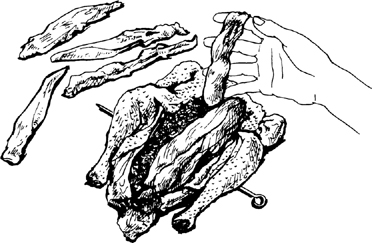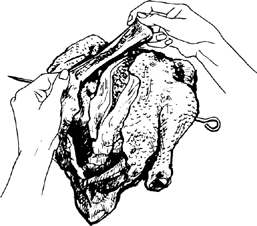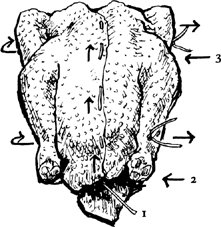Mastering the Art of French Cooking, Volume 2 (117 page)
Read Mastering the Art of French Cooking, Volume 2 Online
Authors: Julia Child

When you are ready to stuff the chicken, cut the breast meat into strips ⅜ inch wide. (You may wish to marinate them in oil, herbs, and wine or drops of lemon juice, or in Cognac as suggested in the following recipe.)
Raise the legs upright, then flex them, pushing knees against armpits (where wings join shoulders). Run a skewer or knitting needle through the carcass at knees as shown; this will hold legs in place for the rest of the operation. Mound whatever stuffing you have chosen in the cavity, building it into a dome at the front to simulate a full breast.
Lay the strips of breast meat over the stuffing.
| Fold the breast skin over the stuffing and breast meat, covering it completely. |
| With white string and either an 8-inch trussing needle, a long mattress needle, or a plastic knitting needle with a hole drilled in the end, truss the chicken. |
1) Sew the 2 flaps of breast skin together as follows: start at the tail end, and leaving a 3-inch piece of string free at that end, stitch a straight line up to the neck. Turn the chicken over and sew the neck skin to the back, completely enclosing the stuffing at the neck end.
2) The second tie is to secure the lower part of the drumsticks and to close the vent opening. Push needle through the lower part of the carcass and the tail piece; come back through skin on top of one drumstick, through lower end of breast, and top of second drumstick. Pull string tight, and tie.
3) For the final tie, remove skewer, and go through carcass at the knees; fold wings akimbo and come back through the underside of one wing, through a bit of the backbone, then through the underside of the second wing. Pull string tight and tie.
Chicken is now ready for roasting, casserole roasting, or for the
poularde poché, à la d’Albuféra
, in the following recipe.
 POULARDE À LA D’ALBUFÉRA
POULARDE À LA D’ALBUFÉRA
[Half-boned Chicken Stuffed with
Foie Gras
, Truffles, Chicken Livers, and Rice; Poached in White Wine;
Sauce Suprême Pimentée
]
One of the more famous chickens boned, stuffed, and poached in white wine is this one, created to honor Maréchal Suchet, who was made Duc d’Albuféra
by a grateful Napoleon after the General’s victories in Spain. The dukedom, a large lagoon surrounded by rice fields with an outlet to the bay of Valencia, was lost in another battle the next year, 1813, but both duke and recipe retained their titles. Curiously enough, as a gastronomical aside to history, the grateful Spanish, in recognition of his role in returning the lost territories to them, awarded the revenues from the Albufera to the Duke of Wellington—perhaps at the very moment a famous
filet
of beef was being named after him. Numerous versions, as is always the way, exist for
poularde à la d’Albuféra
, and we have picked the one we prefer. Not all of them include a small pinch of saffron in the rice, but all do have a Spanish echo of pimento in the sauce.
The vegetable accompaniment should be fresh and simple, we think. Something like the parslied baked cucumbers in Volume I, page 500, or fresh new peas or asparagus tips, or the tender, peeled, fresh
broccoli
in the Vegetable Chapter. We prefer one of the great white Burgundies with this dish, or one of the lovely white Graves—Haut-Brion or La Mission-Haut-Brion.
For 6 people
1)
Preparing the chicken
A 4½-lb. roasting chicken or capon
A dish to hold the strips of breast meat
1½ Tb each of dry port or dry (Sercial) Madeira, and Cognac
1 Tb very finely minced shallots or scallions
Freshly ground white pepper
Pinches of tarragon or thyme
1 or more 1-ounce cans of truffles
2 or more ounces canned
foie gras en bloc
(goose liver: read label on can), chilled for easy cutting





